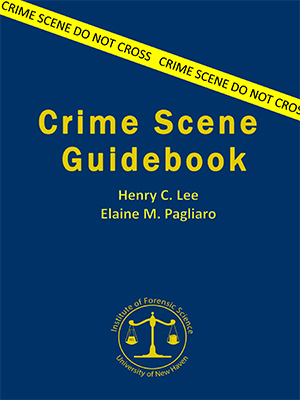Description
 This CRIME SCENE GUIDEBOOK by Dr. Henry C. Lee and the members of the Henry C. Lee Institute has been devised for use in the field and as a review of basic crime scene procedures and protocols. The GUIDEBOOK is divided into three sections to assist those in detective divisions or crime scene units, especially those from smaller departments, in evaluating crime scenes, and assessing what technologies and assistance may be useful in the processes of recognition, identification, and documentation of physical evidence and reconstruction of a crime scene:
This CRIME SCENE GUIDEBOOK by Dr. Henry C. Lee and the members of the Henry C. Lee Institute has been devised for use in the field and as a review of basic crime scene procedures and protocols. The GUIDEBOOK is divided into three sections to assist those in detective divisions or crime scene units, especially those from smaller departments, in evaluating crime scenes, and assessing what technologies and assistance may be useful in the processes of recognition, identification, and documentation of physical evidence and reconstruction of a crime scene:
Section I : Overview of crime scene investigation theory and basic crime scene process. Includes details concerning protocols, crime scene reagents and evidence collection guidelines.
Section II: Information on advanced technologies that are available for use by law enforcement personnel and forensic scientists; many of these instruments may be available at the local forensic science laboratories, universities or forensic science programs. The advantages of these advanced technologies are briefly described. Any equipment or other materials specifically referenced are used for illustrative purposes only and do not serve as an endorsement by the Department of Justice, the National Institute of Justice or the authors.
Section III provides a practical guide to resources, including some useful websites, manufacturer information and some crime scene references. In some cases, manufacturers may provide technical assistance as well as application information. Crime scene investigators and police officers can take advantage of the wealth of information and technology available from these sources.
This project was supported by Grant No. 2009-D1-BX-K031 awarded by the Bureau of Justice Assistance. The Bureau of Justice Assistance is a component of the Office of Justice Programs, which also includes the Bureau of Justice Statistics, the National Institute of Justice, the Office of Juvenile Justice and Delinquency Prevent, the SMART Office and the Office for Victims of Crime. Points of view or opinions in this document are those of the authors and do not represent the official position or policies of the United State Department of Justice.
The authors also would like to thank colleagues at the University of New Haven, President Steven Kaplan, Dean Mario Gaboury of the College of Criminal Justice & Forensic Science, and members of the Department of Forensic Science for their support and assistance with this project.